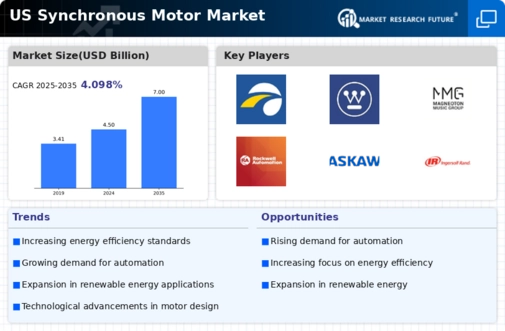Growing Demand for Automation
The increasing demand for automation across various industries is a key driver for the synchronous motor market. Industries such as manufacturing, oil and gas, and water treatment are increasingly adopting automated systems to enhance productivity and efficiency. Synchronous motors, known for their precise speed control and high efficiency, are becoming the preferred choice in these applications. According to recent data, the automation sector is projected to grow at a CAGR of approximately 10% over the next five years, which could significantly boost the demand for synchronous motors. This trend indicates a shift towards more sophisticated machinery, where synchronous motors play a crucial role in ensuring operational reliability and energy savings. As industries continue to invest in automation technologies, the synchronous motor market is likely to experience substantial growth, driven by the need for advanced motor solutions.
Rising Focus on Energy Conservation
The rising focus on energy conservation is significantly impacting the synchronous motor market. With energy costs continuing to rise, industries are increasingly seeking solutions that enhance energy efficiency. Synchronous motors are recognized for their ability to operate at higher efficiencies compared to traditional induction motors, often exceeding 90% efficiency. This characteristic makes them an attractive option for energy-intensive applications. Furthermore, regulatory bodies are implementing stricter energy efficiency standards, which further propels the adoption of synchronous motors. For instance, the U.S. Department of Energy has set forth regulations that encourage the use of high-efficiency motors in industrial applications. As organizations strive to reduce their carbon footprint and operational costs, the synchronous motor market is poised to benefit from this growing emphasis on energy conservation.
Technological Innovations in Motor Design
Technological innovations in motor design are significantly influencing the synchronous motor market. Advances in materials science, control systems, and manufacturing processes are leading to the development of more efficient and compact synchronous motors. These innovations not only enhance performance but also reduce the overall lifecycle costs associated with motor operation. For instance, the introduction of high-temperature superconductors and advanced magnetic materials is enabling the production of lighter and more efficient motors. The market for synchronous motors is expected to benefit from these advancements, as industries seek to optimize their operations and reduce energy consumption. Furthermore, the integration of smart technologies into motor systems is likely to enhance monitoring and control capabilities, making synchronous motors even more appealing to end-users. As these technological trends continue to evolve, they are expected to drive growth in the synchronous motor market.
Expansion of Electric Vehicle Infrastructure
The expansion of electric vehicle (EV) infrastructure is emerging as a significant driver for the synchronous motor market. As the U.S. government and private sector invest heavily in EV charging stations and related technologies, the demand for efficient electric motors is expected to rise. Synchronous motors are increasingly being utilized in electric vehicle applications due to their high efficiency and performance characteristics. The U.S. EV market is projected to grow substantially, with estimates suggesting that EV sales could reach 30% of total vehicle sales by 2030. This growth will likely necessitate the integration of synchronous motors in various components, including charging systems and electric drivetrains. Consequently, the synchronous motor market stands to gain from the burgeoning EV sector, as manufacturers seek reliable and efficient motor solutions to meet the demands of this evolving industry.
Increased Investment in Renewable Energy Projects
Increased investment in renewable energy projects is driving growth in the synchronous motor market. As the U.S. transitions towards cleaner energy sources, there is a growing need for efficient motor solutions in wind and solar energy applications. Synchronous motors are particularly well-suited for these applications due to their ability to maintain constant speed and high efficiency under varying load conditions. The U.S. renewable energy sector is expected to see investments exceeding $100 billion in the coming years, which will likely create substantial opportunities for synchronous motor manufacturers. This trend indicates a shift towards sustainable energy solutions, where synchronous motors play a pivotal role in enhancing the efficiency of renewable energy systems. As more projects come online, the demand for synchronous motors is anticipated to rise, further solidifying their position in the market.





















Leave a Comment